
|
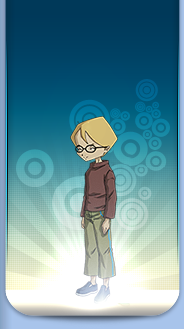 |
Japanese culture in Code Lyoko
| | | As we've seen in other files, Code Lyoko is inspired by a scholarly mishmash of previous monsters of science fiction. Dotted with artistic of historical allusions of all kinds, although it's aimed at a younger audience, it's nevertheless very rich and steeped in culture.
Among all the culture that the series and its writers cultivate, one in particular shows up the most: Japanese culture. Obviously, those newest to Japanese culture think only of the Japanese Yumi, transformed into a geisha in the virtual world, and her brave knight, the samurai Stern...
The more Japan-savvy on the other hand would notice that Yumi's character and the universe that gravitates around here are full of references, objects and an extremely Eastern atmosphere that manifests itself in many ways.
But as Yumi has had enough of being mistaken for Chinese, she offers you a general tour of discovery of just how much the culture of her ancestors' spirits have influenced Code Lyoko and manifested throughout the series. Does that interest you? Then come on in!
You should have seen the following episodes before reading this file:
Summary
[Yumi, Japanese through and through] [Virtual bushi] [Design and creation of Lyoko: a Franco-Japanese mix?] [The Ishiyama family: a traditional Japanese family] [At the Ishiyamas': a window into Japanese culture in France] [Elements in bulk] [Last cultural point: the nationality quarrel!] | | |
 | Yumi, Japanese through and through | |
|  | Let's firstly remark that the word “yumi” means “bow” in Japanese.
Not your typical bow, rather the traditional Japanese bow that the Japanese use to practise the ancestral art of Japanese archery: kyûdô.
However, without seeing the kanji (a Japanese script) spelling of Yumi's name, it's impossible to tell what it really means as a name.
Yumi is very proud of her heritage.
We notice this in episode 10, during which she does a presentation on this subject in front of her class...with consequences we're familiar with.
Nevertheless, we see that aside from a certain pride visible to everyone, Yumi was raised and behaves Japanese.
She practises martial arts, and is very attached to symbols of personal affection (like wishing someone a happy birthday (episode 78 “Lab Rat”)), as well as her country's traditions, like not opening a gift in the presence of the person who gave it to you.
Yumi's Japanese heritage is also translated into her behaviour.
Firstly from an emotional point of view: to Ulrich's great displeasure, Yumi is extremely reserved, which doesn't help their relationship. It's Japanese etiquette to retain dignity and avoid emotional outbursts in public. This also explains her very sombre black clothing and her rage when Odd put her in a publicly embarrassing situation three times:
The first when he posed in Ulrich's arms for the Kadic News when he was stuck in Yumi's body (episode 42 “A Fine Mess”).
The second in the same episode, same context, when he came to Kadic dressed in more eccentric clothing than what Yumi would normally wear.
The last in episode 92 “Cold Sweat” when he sent the Kadic News a photo of Yumi as a kid, dressed in a ridiculous princess dress.
Finally, two positions that can appear unnoteworthy, but are characteristics of Yumi's heritage.
The first, very stealthy one, is the posture she adopts on two occasions in episode 22 “Routine” when she was telling Ulrich off about Emily: straight as a post with her arms rigid at her sides and slightly behind, with her chest puffed out.
This is the usual posture Japanese youngsters take to show their discontent in a discreet and prudent manner. The pose shows the will to signify they're being defensive while showing that they're being offensive.
The second, more evident to the well-informed eyes of someone knowledgeable about Japan: the way she hands Ulrich his diary in episode 4 “Log Book”.
She stands straight and holds it out to Ulrich in front of her, holding it in both hands. While he also takes it in both hands, they hold it together for a few seconds, the time to exchange a few gallantries before Yumi lets it go.
This ritual is the Japanese way of offering someone a gift (or giving your business card when presenting yourself). This little exchange so plunges the scene into even deeper significance than it already had: Yumi doesn't just give Ulrich his diary. She makes it a gift. Combined with the verbal exchange they have at this moment, it's a form of declaration, as if Yumi accepted the contents of the diary.
|  | |
|  | Yumi, geisha of Lyoko?
The idea that Yumi would be a geisha has been largely popularised. This idea is nonsensical however, as in no case would a geisha ever have to take part in combat.
A geisha is actually a woman of art. Geishas were women who had to accompany noble men in practising different Japanese arts, from music to literature and tea ceremonies. This high social class unfortunately often hit rock bottom by being mixed with movements of prostitution and classes of all kinds. Yeah, sorry to break the myth!
And so Yumi isn't a geisha as such, although her appearance is obviously almost identical to theirs. Here are the main elements:
The traditional silk kimonos that they wear. Yumi's is probably inspired by the geisha doll that Yumi keeps in her room. It doesn't necessarily correspond with an existing form. In terms of colours, it is red and black, but vibrant colours (like red) are reserved for young geishas, while muted colours (black) are for older women. As such the dress is a hybrid... What's more, Yumi's kimono was largely shortened and streamlined from the original model in order to facilitate the Japanese girl's fighting.
Her kimono is tied with a large obi, a traditional multi-form sash for Japanese kimonos. They vary according to their height and especially their knots, which are extremely complex and demand much hands-on learning to do. Yumi doesn't need this however, seeing as she's virtualised with her obi already tied. Its appearance resembles a "tateya" or "bunko" knot. Yumi's obi is rather plain in the sense that unlike most obis, it is a single colour and has no pattern.
In season 4, the remnants of the obi on Yumi's back is tied in more of an "otaiko musubi" knot.
Her shoes are a particular form of Japanese shoe: okobo.
The rest of the lower half of Yumi's outfit doesn't correspond to what geishas normally wear.
Yumi's face, made up in white with blush on her cheeks, unlike what one would think, is not what a geisha would have: geishas stop wearing make-up as they progress in their art.
Make-up was actually more reserved for apprentice geishas: maikos.
On the other hand, Yumi's virtual avatar's hairdo is definitely a traditional geisha thing, up in its simple bun. As an anecdote: geishas sleep with a neck rest so as not to flatten their hairstyle, which must stay up for at least a week after being done.
Final point, Yumi's combat fan isn't inspired by anything relevant. We do know however that one Asian combat sport uses fans in hand-to-hand fighting... An Indonesian sport named pencak-silat.
 Ulrich, the false samurai?
Ulrich, the false samurai?
Although you may not like it, in the same way Yumi is a false geisha, Ulrich is a false samurai. The traditional samurai always has two sabres: one short (the wakizashi) and one long (the kanata). Ulrich only has one or two katanas.
Ulrich's socks are tabis: they separate the toes. His shoes are largely inspired by traditional Japanese sandals, halfway between zôri and waraji.
His kimono, although associated with that of a samurai, is largely fantastical. The origin of the symbol on his back is difficult to determine.
It's most likely inspired by nô masks, of the "noble" theatre of Japan. In nô performances, some actors wear masks. They shape their masks into deformed expressions, ones that are derisive and hard to hold. The face on Ulrich's back, all white, featuring horns and a jesting expression, closely resembles the masks that were used to portray gods (kami), demons (oni), nature spirits and other immortal characters from Japanese folklore who descended to Earth to punish or torment mortals.
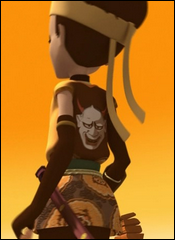 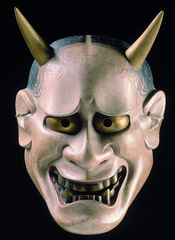 The resemblance is really striking it makes us wonder if Tania Palumbo created this design based on this particular nô mask!
The resemblance is really striking it makes us wonder if Tania Palumbo created this design based on this particular nô mask!
The other symbols on Ulrich, notably the one on his chest and kimono, strongly resemble symbols from different Japanese clans worn by their members.
Last point, let's note that pencak-silat isn't a Japanese martial art, but Indonesian. |  | |
 | Design and creation of Lyoko: a Franco-Japanese mix? | |
|  | The origins of the Japanese influence in Code Lyoko goes back a long way. Since Garage Kids, the base project for Code Lyoko, Yumi's character was already Japanese. Ms Decroisette, writing director for seasons 1 and 3 of Code Lyoko, confirmed an element many had already considered: Tania Palumbo and Thomas Romain, the two ex-Gobelins students and creators of Garage Kids were well and truly Japanese culture enthusiasts.
And so the Japanese ambience originally came from them.
Later, as we know, Thomas Romain left the project to concentrate on another cartoon: Oban Star Racers, which also contains a number of references to the Japanese world. But that's not our topic here.
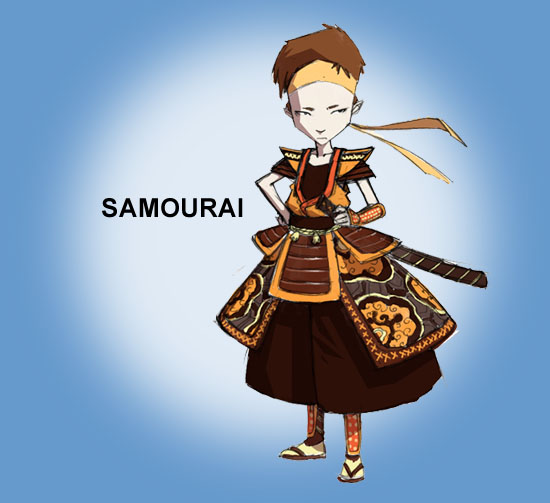 Ulrich in Garage Kids.
Ulrich in Garage Kids.
His outfit more closely resembled those of real samurais.
So Tania Palumbo found herself as artistic director on the project. She created all the characters. Ulrich was already a samurai in virtual form in Garage Kids, and he kept this attribute even with his different outfit. He was joined by Yumi, geisha of Lyoko.
In terms of design, we notice that Tania Palumbo never stopped being influenced by Japanese style. The evolution of the outfits themselves speaks for this attachment.
Indeed, the more the series progressed, the more futuristic the heroes' outfits got. We now know that, in the series, the outfits were originally created by the Supercomputer analysing the person's subconscious, and Jeremy then developed them as he pleased. The same goes for their powers.
When the season 4 outfits were revealed, many people compared them to the ones in “Power Rangers”. Without drawing a parallel with this representation of Japanese culture that some would consider low-end, the Japanese influence is still an important aspect of the heroes' new, futuristic outfits.
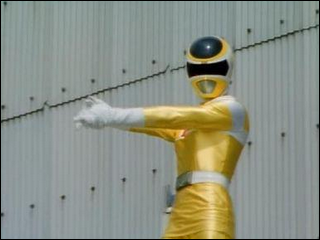 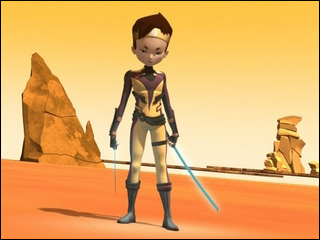 It's over, right?!
It's over, right?!
Some might not understand how the outfits from seasons 1 to 3, turned towards Japanese archaism and traditionalism, could come from the same sort of influence as what inspired the futuristic season 4 outfits.
The explanation is simple: Japan is the one and only country that has always had its history and traditional culture soundly coexist with avant-garde technologies resulting from humanity's progress. In Japanese mentality, heritage and discoveries can mix together into the one thing.
Tradition and cutting-edge... The two make up Japanese society... And Code Lyoko takes after both of them!
We're going to finish this part with cutting-edge stuff because its impact on Code Lyoko is rather general in the lines of direction, while traditional Japanese influences are more numerous and are based on more concrete facts.
One of the keys to Code Lyoko's success is its Japanese inspiration. Indeed, from the series' beginning in 2004, France was already at the peak of its Japanophilia. The manga movement, born in the 70s/80s, grew in the 90s and reached a new peak with the new media giants from the current manga generation (Bleach, Naruto, etc...).
Code Lyoko jumped on this successful bandwagon.
Innovating with its mix of 2D and 3D, Code Lyoko was a wealth of different codes from the manga/anime universe. It was the first such French cartoon and its international success was proof of the correctness of this choice.
All the futuristic aspects of the Code Lyoko series came from the Japanese archipelago. Japan is the leading country in technology and computing. It's in this country that the a key science fiction concept was born: the fight between man and machine...an artificially intelligent machine self-aware enough to emancipate itself and super-technologies of all kinds.
Hopper, XANA, the Supercomputer and the scanners are all estranged children of this Japanese culture of innovative technology.
From there, there's a long list of manga that Code Lyoko could be compared to due to resemblances between their scenarios oriented towards new technologies. But we won't make that list here. You've got the idea and the fact that Code Lyoko is derived from futuristic Japanese science-fiction series is the main thing.
Just one notable comparison:
Aelita's hair. Its pink colour is in no way natural. Though this point isn't too shocking for a virtual creature, it becomes so when we know that Aelita is from Earth...and that her pink hair is genetic, passed down from her mother.
This point is the only stylistic element of the real world in the series...that's unreal.
For those who don't know, this hair colour is a choice made by Tania Palumbo, whose hair is also dyed.
And from which country comes fantastical hair colours? Japan, of course. A large number of mangas present characters with hair of all colours: blue, green, purple, there's something for everyone. You need to know that this phenomenon has a social dimension in Japan, among young Japanese people mostly. Some of them have a certain "complex" with their hair, which is usually black. With the world opening up more and more, some Japanese people found themselves wanting blond and brown hair (and that's not all), like Westerners. This is where fictional characters with all sorts of hair colours came from, as well as why Japanese youth dye their hair in all sorts of ways on a scale that surpasses a simple fashion statement.
All that to say that Aelita's pink hair undoubtedly reminds us of the manga universe. Now we've talked about futurism, let's dive into ancestral Japan! |  | |
 | The Ishiyama family: a traditional Japanese family | |
|  | Yumi's family is a key component of the series. It's the only one of the heroes' families that's really exploited, and as such its role in the series is regular and relatively important due to the invasive presence of Yumi's parents in her life, and the appearance of Hiroki in season 2.
We don't know if Yumi and her brother have been to Japan, or even if they know Japanese. Only the Code Lyoko Chronicles mention that Yumi was born in Japan and that her parents emigrated to France after her birth.
In episode 35 “The Chips Are Down”, Yumi talks about her parents wanting to "go back" to Japan.
Our first stop is on the geographical origins of the Ishiyama parents. Mrs Ishiyama says in episode 34 “Missing Link”: "My mother warned me not to marry a man from Tokyo!".
Japan is a country with two kinds of regions. The island is separated in the middle by an imaginary line. In the east, on the Pacific side of the country, is an immense megapolis: a vast conurbation grouping together dozens of immense cities that are almost touching. It's in eastern Japan that a large part of the population lives. This "Fukuoka-Tokyo" axis is the heart of the country from an economical and commercial point of view.
On the other side, all along the west cost and on the northern island of Japan, Hokkaido, is an almost depopulated and much more rural place, much less connected by transport routes. In this part of Japan that's much more stagnant than the highly-charged megapolis, the world is more rural.
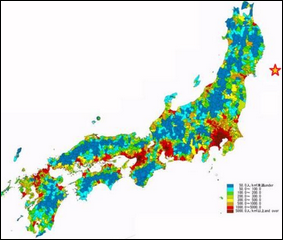 On this map, we can clearly see the overpopulated south/east coast and the depopulated north/west side!
On this map, we can clearly see the overpopulated south/east coast and the depopulated north/west side!
There's quite obviously a noticeable cultural difference between the eastern Japanese "city folk" and western, who are much more "farmers". Mrs Ishiyama's sentence leads us to believe that Mr Ishiyama is from Tokyo, "the" city, while she herself hails from rural Japan, where marrying without your parents' favour is still inconceivable nowadays.
This is where Mrs Ishiyama's slightly acidic remark towards her husband came form. Yumi's maternal grandmother had a rather negative opinion of "city folk" because in Japan, they're extremely busy with their work and can sometimes neglect their family. In the context of the episode, Mrs Ishiyama feels ignored by her husband and then reminds him of her venerable mother's advice, which she hadn't followed by marrying Yumi's father.
Now and nevertheless, the Ishiyama family is well settled in France.
However, their integration hasn't taken away from their Japanese cultural roots. The family itself rigorously respects the Japanese ideal of a family.
The father, Takeho, takes the role of determiner.
He's the guardian of the family's well-being: only he works regularly to cater to the family's needs. He bitterly reminds his spouse of this fact on a few occasions. He must also keep up the family morale. This is also why it's very bad for father Ishiyama to have lost his job. In Japan, losing your career is a distressing event and extremely hard to take...
It's also the father who orders close surveillance on his daughter in episodes 29 “Exploration” and 30 “A Great Day”, due to repeated late night returns to the family home. The father worries that she's with a boy.
The mother, however, has her own role to fill.
Responsible for the house, she ensures it is properly kept. This vision is relatively sexist from a modern European point of view, but corresponds with the traditional image of a Japanese family...and we've seen that Mrs Ishiyama certainly comes from a more conservative background.
Like in most societies, the children must respect their parents. This is particularly true of Japan.
Though Hiroki is rather immature and very eccentric, we notice that he obeys his parents more than he does his sister. He fears a negative reaction from them (episode 87 “A Space Oddity”) and complies with orders (episode 29 “Exploration”). Yumi does too.
The Father-Child relationship is very strictly defined in Japanese society. We find the same is true in Code Lyoko. The father must be loved and respected for his role as the family's support...but above all, he must be feared because his decisions are implacable and indisputable.
The Ishiyamas are no exception to this rule. The father takes his role seriously and doesn't appreciate being upset or talked back to, while Mrs Ishiyama is much more pleasant and compassionate with her daughter.
As such, it's extremely hard for Yumi to lie to her parents about her secret life - much more so than for the other heroes. She confesses to her friends that she doesn't like it. She's very involved in her schoolwork because she knows that her parents won't tolerate a poor report card: success in school is vital in Japan, where young people are often driven to extremes due to pressure in school.
We finish this passage by noting that towards the end of the season, the role of Yumi's parents turns more towards comic relief as an old married couple, and the Japanese dimension of the family is explored less than before, which is regrettable in some way. |  | |
 | At the Ishiyamas': a window into Japanese culture in France | |
|  | The Ishiyamas' house is a real traditional Japanese house in France.
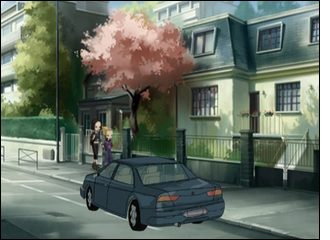 The tone is immediately set at the front door by the sakura planted in the garden. The tone is immediately set at the front door by the sakura planted in the garden.
This Japanese cherry blossom tree (which comes in numerous species) is one of the country's traditional symbols. Globally known for its flowers and young pink leaves upon blooming, the Japanese made it a national symbol centuries ago. Its repeating bloom represents the eternal rebirth of Japan. In a period of war, a popular belief was that dead soldiers were reborn as cherry blossoms. Their comrades were also supposed to be reborn on the same tree.
In the series, production restraints and the fixed background images forced the tree to remain permanently in bloom. However, in real life, the tree blooms for one week; a week of festivities on the Japanese archipelago.
Once inside, we dive into national culture. As we've said, Japan has always had tradition and innovation coexist. Such can be found in Japanese houses and apartments and in the Ishiyamas' house.
The decoration is often archaic, while the appliances in the house are modern. This layout is followed perfectly at Yumi's house. And so we find one floor covered in carpet and another in tatami, while the kitchen is modern.
The Japanese house must cultivate an architectural philosophy (yes!). As such, everything needs to be conceived in a way that's functional, while taking up the least amount of space possible. So the furniture follows this logic: some of the walls, far from thick, are sliding doors that can be moved and reorganised easily. As for the tables, the ones in the living room are very low to the floor.

This layout can be found in the bedrooms, with low beds close to or even on the floor, which are typical of Japanese houses - called futons. We notice that the room is in order, which is a dominant aspect of Japanese living; in Yumi's absence, the bed is always made.
What's more, her room is always extremely well-kept, both in the room itself and in her closets.
We'll get to the components of Yumi's room later.
The bathroom merits some attention.
Although nowadays personal hygiene is capital in developed countries, this hasn't always been the case...except in Japan. In the XVIIIth century, the Japanese were always considered by historians to be the most proper people of the world.
In Japan, bathing is an obligation...which must be done multiple times per day. In poorer villages, farming families get together to share a large public bath where the villagers can bathe regularly, no matter their financial situation.
From there a culture was born around the art of bathing oneself. The Japanese developed a taste for hot baths warmed by natural sources. These immense therapeutic baths, or hot springs, are called rotenburo.
The almost disproportionate bath at the Ishiyama house and the bathroom that's always filled with steam from hot water is testimony to the fact that the Ishiyamas haven't renounced this tradition. Each time Yumi washes herself, we see her do it in a bath and not a shower, because showers aren't popular in Japan. |  | |
|  | Let's finish with the array of decorative elements and utilities
Chopsticks, indispensable elements of a Japanese family and the Asian equivalent of our fork.
While we're talking about food, Japanese gastronomy is sure to follow: sushi, noodles or even sashimi...
I won't expand any more on the subject, it's generally pretty well-known.
The calligraphy hanging on the wall... Initially a Chinese art that spread to Japan, calligraphy is the art of drawing characters of the Japanese alphabet with a paintbrush and Chinese ink.
On the same topic, we find splendid paintings of the Japanese countryside in other shots, painting being a typical subject at Japanese art schools.
The game of go.
This board appears a few times, in the Ishiyama house and in the factory in episode 53 “Straight to Heart.” It's a strategy game that originated from China, but is extremely popular in Korea and Japan. It's notably Japan that gave it this name and made it globally known.
This board game has very simple rules but has an almost unrivalled level of strategy to it.
The bonsai in Yumi's room is also worth mentioning. This tree, originating from Japan, is extremely hard to grow and dies very easily. Maintaining it so it survives is a challenge and a true art form in Japan. We have to wonder how Yumi finds the time to do it with her double life.
Finally, only the most observant will have noticed it, but Yumi's room contains a splendid statuette of a geisha which surely influences the imagination, and our heroine's virtual avatar.
Still in Yumi's room, this nice plush toy!
It's straight out of an animated film that's a household name in Japan: “My Neighbour Totoro”. The character it represents is none other than Totoro, so popular that he has become the icon of Studio Ghibli in the same way Mickey Mouse is Walt Disney's icon.
Probably the most determinate traditional Japanese object the Ishiyamas own.
The samurai armour from episodes 10 “The Girl of the Dreams” and 39 “A Bad Turn” isn't just a mere family heirloom, nor is it a simple historic object of valour.
The samurai class possessed a number of beliefs and superstitions. The first of them is the cult of the dead. For some Japanese people, the dead continue to live in the beyond so long as those who are still alive, their descendants, continue to keep their memory alive. Keeping family treasures is thus a way of honouring the dead and assuring that their spirit lives on for eternity. It's a moral duty for the descendants to do this, because if they don't do it, their children won't do it, and all their souls will be haunted.
Second point, samurai warriors considered that they were tied to their tools, and especially to their sabre. As such, this weapon receives a part of their soul and becomes a part of the samurai themselves. This tradition has persisted and even the kamikaze pilots during World War II took their sabres with them in their planes when flying to their deaths against the American ships.
So, when a samurai dies, his sabre can do one of two things: be buried with its owner, or be passed down to his descendant. In the second case, the descendant then links his own soul to the sabre. The sabre with the Ishiyama samurai armour therefore, according to Japanese culture, holds all the souls of their ancestors who wielded it.
Being obliged to separate themselves from Japanese treasures is a most awful thing for these people. It's even improbable that the parents ever agreed to risk having their daughter bring it to school...
But that will be nitpicked around episode 10! (On another note, where did Taelia disappear to?) |  | |
 | Last cultural point: the nationality quarrel! | |
|  | Everyone remembers the gag from Code Lyoko's Prequel: “XANA Awakens”, where Sissi called Yumi Chinese, which makes the heroine firmly retort that she's Japanese.
And in episode 42 “A Fine Mess”, Odd is stuck in Yumi's body and speaks in Chinese, which irritates Yumi.
Indeed, for many Westerners, the difference between the two is almost non-existent and everyone with slanted eyes is quickly labelled as Chinese. However, a French person wouldn't consider themselves English or Spanish...
Nevertheless, these gags, although they seem harmless, are heavy with significance if we break out of the strict sphere of the series.
China and Japan are two countries full of people who are very proud of their nation. They have always had a troubled relationship: economic and cultural exchanges between the two are innumerable, but politically, the two countries have been enemies for a long time.
Up until the XIXth century, China had only considered Japan as a small servant country and submissive to the great Middle Kingdom. In the XXth century, Japan defeated its Chinese cousin on several occasions thanks to far superior modernisation.
The culminating point is hit during World War II. Japan invaded China in a long and bloody war and the Japanese committed war crimes worthy of Nazi soldiers.
Even with the war's end, tensions between the two countries have never fully settled because Japan refuses to recognise the war crimes it committed on Chinese soil. In the past the two peoples often mutually considered each other inferior races, and this old historic resentment still persists in far-east Asia.
That's why you should NEVER call a Japanese person Chinese (or vice-versa). |  | |

|
 |

















